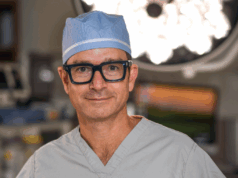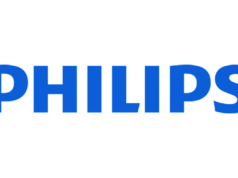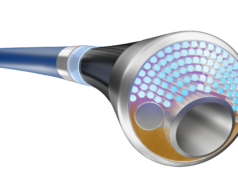
The early months of 2020 have seen the emergence of new technologies in the intraoperative navigation space. Here, Vascular News considers Philips’ Fiber Optic RealShape (FORS) technology and Centerline Biomedical’s IntraOperative Positioning System (IOPS)—data on which have been presented at various meetings in recent months.
FORS technology “will reduce X-ray doses and contrast volume”
At the 2020 Leipzig Interventional Course (LINC; 28–31 January, Leipzig, Germany) and, more recently, Critical Issues America (7–8 February, Coral Gables, USA), Tilo Kölbel (University Medical Center Hamburg, Hamburg, USA) spoke about how the recently-launched FORS technology enables 3D navigation using laser light in complex aortic repair.
At Critical Issues America, Kölbel began his presentation on FORS technology by comparing its introduction in 2020 to the establishment of colour TV in 1958. He detailed that the new technology, which has received CE mark—is composed of two catheters and a hydrophilic guidewire, adding that “embedded optical fibre enables real-time 3D [three dimensional] visualisation of the full shape of devices inside the body without the need for fluoroscopy”.
Kölbel concluded that FORS technology allows 3D navigation by visualising catheters and guidewires in full shape 3D using laser light, adding that there is a high potential for reduction of radiation and workflow improvement by intuitive virtual biplane visualisation. “Revolutionary new tools are on the horizon,” he informed delegates.
At this year’s Controversies and Updates in Vascular Surgery annual meeting (CACVS; 22–25 January, Paris, France), Joost van Herwaarden (UMC Utrecht, Utrecht, the Netherlands) discussed the benefits of FORS technology to reduce contrast volume and X-ray dose.
Van Herwaarden began by outlining the disadvantages of X-ray navigation, noting in particular the poor quality of the greyscale images produced by 2D navigation. He then mentioned that with FORS, it is now possible to show guidewires in 3D and in distinctive colour using light instead of X-ray.
Comparing the current “gold standard” of 2D imaging to imaging with FORS, van Herwaarden reported cannulation times of 45 minutes with the former and 2 minutes 20 seconds, respectively. Coresponding fluoroscopy times were 5 minutes 45 seconds with 2D imaging compared to no time at all with FORS.
Van Herwaarden then announced clinical results of a first-in-human study. He outlined that the objective was to assess the feasibility of using FORS technology in endovascular aortic and peripheral procedures. Consecutive patients scheduled for standard or complex (fenestrated/branched) endovascular aneurysm repair (EVAR) or for iliac or superficial femoral artery (SFA) percutaneous transluminal angioplasty (PTA) were included between July and December 2018.
In all, 21 patients were assessed: 14 endovascular aortic repairs and eight peripheral endovascular procedures. A total of 66 navigation tasks were set, including passing stenotic lesions and the catheterisation of contralateral limb or target vessels. Sixty of these tasks were completed successfully using a FORS catheter and/or FORS guidewire, representing 91% of the target. Five tasks could not be completed successfully with FORS because different catheter shapes were needed, and one task, a recanalisation, failed.
Van Herwaarden concluded that FORS appears to be a “promising new technology”, making navigation possible without fluoroscopy. “It is very likely that use of FORS will reduce X-ray doses and contrast volume,” he added. Looking to the future, van Herwaarden noted that expansion of the FORS platform and further clinical trials are needed to prove the benefits.
IOPS: “A way to leverage the capabilities of AR and AI”
Another emerging technology is Centerline Biomedical’s advanced surgical navigation system known as IOPS. The company’s IOPS platform is a navigation system for minimally invasive surgery, leveraging anatomical mapping and electromagnetic tracking to provide 3D colour visualisation and real-time guidance during endovascular interventions with minimal need for fluoroscopy.
During the panel discussion following Kölbel’s FORS presentation at this year’s Critical Issues America meeting, Mark Farber (University of North Carolina, Chapel Hill, USA) spoke about the benefits of IOPS, noting in particular that IOPS is “a separate unit that can work with pretty much any imaging system—Philips, GE, Siemens”.
The first IOPS product from Centerline, recently granted US Food and Drug Administration (FDA) 510(k) clearance, allows doctors to navigate catheters and guidewires through complex anatomy with highly intuitive and safe imaging. The pipeline advancement technologies, still in preliminary stages of growth, are intended to develop the technology to the next generation, with augmented reality (AR) visualisation and software assistance in guidance.
According to a press release from Centerline, IOPS technology represents a “revolutionary step forward” and it is hoped that it will provide a way to leverage the maturing capabilities of AR and artificial intelligence (AI). As the IOPS data platform grows, AI may be able to provide further navigational aids based on prior surgical experience. By simplifying complex procedures and making them faster, safer, and more accurate, Centerline hopes to decrease costs while improving access to care.
At VEITHsymposium 2019 (19–23 November, New York, USA), Matthew Eagleton (Massachusetts General Hospital, Boston, USA) announced first-in-human use of IOPS and speake in detail about the technology on behalf of Centerline.
Eagleton described how Ezequiel Parodi (University of North Carolina, Chapel Hill, USA) joined staff at the Clinical Centre of Serbia Vascular Centre in repairing two patients’ aortic aneurysms. Attending surgeon Igor Končar (University of Belgrade, Belgrade, Serbia) noted that IOPS enabled manipulation of guidewires and catheters without the need for active radiation, commenting, “Using IOPS I released the fluoroscopy pedal and felt a sense of calm which I never had before, because for the first time I was navigating without hearing the pumps and sounds of the fluoro system.” Končar was also able to identify a possible new use for the system. “We cannulated the AAA [abdominal aortic aneurysm] contralateral limb on the first attempt with IOPS.” Both patients are doing well and the surgeons are pleased with the system, he noted.
At the Vascular and Interventional Advances 2019 meeting earlier that month (VIVA; 2–7 November, Las Vegas, USA), Centerline was one of 11 companies selected to present during sessions on disruptive technology for endovascular therapy. Company chief technology officer Vikash Goel presented the IOPS technology to an audience of vascular surgeons, interventional radiologists, other clinicians, representatives from the endovascular device industry, and regulators.
In the presentation, Goel shared information about the first product, recently cleared by the FDA and preparing for market launch, and discussed results in testing pipeline technologies which leverage augmented reality for next-generation guidance.
Goel was joined at the conference by the other lead inventor of IOPS, Karl West, who currently serves as director of medical device solutions at Cleveland Clinic (Ohio, USA), as well as Centerline’s new CEO Phil Rackliffe, who brings significant experience in global healthcare product launches. The company is presently preparing for a market launch this year, while continuing to develop and expand the technology platform and pursue European market clearance.













